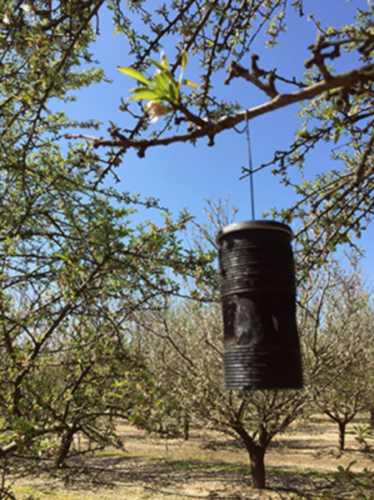
Mar 9, 2021Navel orangeworm monitoring starts now in almond
The fight against navel orangeworm (NOW) is a year-round effort. NOW remains one of the biggest threats to a grower’s crop – and bottom line – due to the potential nut damage caused by worms and the risk of aflatoxin contamination.
Growers’ battle against NOW takes different forms during the year. In the winter, growers remove mummies with sanitation. During bloom and the beginning of nut set, growers must eradicate the first generation, or “flight,” of moths that spur the exponential growth of future NOW generations each season.
Use traps to track rates
Pest management experts say the primary thing growers should be doing this time of year to combat NOW is putting out pheromone and egg traps to help determine NOW levels in their orchards.
Pheromone traps monitor the flight of male moths. It is recommended that growers hang one trap per 50 acres, or at least two per orchard, in the tree canopies about 6 to 8 feet off the ground. The best time to place traps is in early March.
The University of California (UC) Integrated Pest Management (IPM) guidelines advise growers to “count the number of moths in the trap at least once per week and track the data to identify adult flight.” It is also important to correctly identify NOW moths, which are characterized by their “irregular, silver gray and black forewings and legs and a snoutlike projection at the front of the head,” as pheromone traps also attract meal moths, which are light brown with dark brown bands on their wings.
UC IPM guidelines recommend that growers place egg traps in their orchards by March 15, and that there be at least one trap for every 10 acres, or a minimum of four traps per orchard. More traps – as many as 10 per orchard – allow for a more accurate estimate, experts say.
Egg traps are made up of black plastic tubes with mesh siding and snap tops, and are one half- to three-quarters full of almond presscake laced with 3 to 10% almond oil. Growers can also grind almond or pistachio mummy nuts to use instead of presscake.
Traps should be monitored for NOW larvae eggs 1 to 2 times a week, and are most effective during the first flight of NOW in April and May. The UC IPM website offers a monitoring form (PDF) growers can use to help keep track of the number of eggs per trap during the monitoring period.
Growers can consult the UC IPM website for treatment options, in addition to speak with their pest control advisors (PCA).
Mating disruption puts monitoring into action
Josette Lewis, director of Agricultural Affairs for the Almond Board of California, recommends growers work with their PCAs to integrate mating disruption methods into their orchards.
Mating disruption interferes with the ability of male NOW moths to find mates. It involves strategically placing “dispensers” throughout the orchard, which flood the air with a pheromone that disrupts the male’s ability to find females and mate, thus delaying or reducing mating and egg deposition.
Lewis suggested small growers consider working collaboratively with their neighbors “as the technology works best over 40 acres.” She also said there is incentive funding available from the U.S. Department of Agriculture’s Natural Resources Conservation Service (NRCS) to help offset the cost of mating disruption. (For more information on NRCS incentive funding, contact your local NRCS district office.)
At Almond Board of California’s Navel Orangeworm Summit last year, Blue Diamond’s director of member relations, Mel Machado, reported that Nonpareil rejections caused by NOW damage are generally below 1.5% across the state, but that in 2017 the levels rose to 2%. When total losses are considered, he said, NOW damage at the 2% reject level can cost growers about $450 an acre, which is $4,500 for a 10-acre plot.
In comparison, according to Jonathan Hoff of Monte Vista Farming Company, who also spoke at the summit, a NOW control program, including sanitation, sprays and mating disruption and informed by monitoring, costs about $250 per acre – a savings of $2,000 per 10-acre plot when you consider the repercussions of rejected product.
To learn more about the costs associated with NOW damage and what you can do to avoid them, check out this presentation from the Navel Orangeworm Summit hosted by the Almond Board of California in June 2019.
-Almond Board of California







